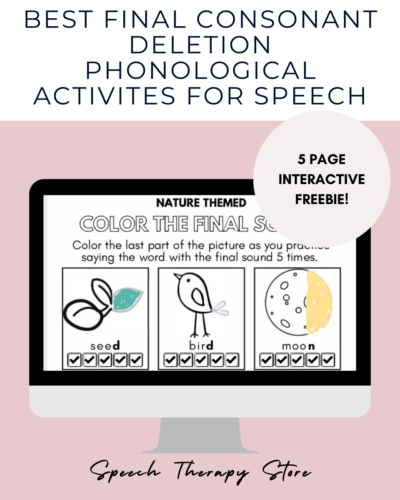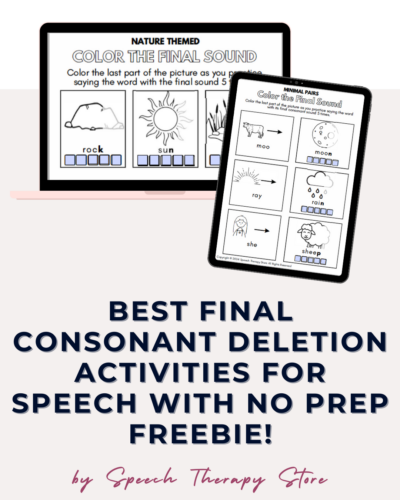Final Consonant Deletion: Understanding What it is and Helpful Tips
If you teach speech or have been around young children who drop the final sound in a word, then you know that Final Consonant Deletion is a common phonological disorder.
- Final Consonant Deletion – is omitting the final consonant of a word, which alters the meaning of the word and affects speech clarity. This pattern of speech is considered a phonological process, where systematic sound errors (dropping the final consonant sound) are made by children as they simplify spoken language.
Understanding Final Consonant Deletion as it relates to language development is crucial if you are a parent, educator or speech-language pathologist. The approach we take with the phonological process of final consonant deletion should consider development and the type of intervention. Early identification is important as it can be indicative of development or signal a speech sound disorder.
During my speech therapy sessions, I often saw final consonant deletion, so whether you are the parents, speech therapists or teachers of a student with this phonological disorder, we want to make sure you feel prepared with knowledge, teaching tips and resources to help them! At the bottom of this blog post, we have created a final consonant deletion freebie just for you!
Key Takeaways
- Identification of final consonant deletion is important for early intervention in speech disorders.
- A structured approach to speech therapy can help children overcome phonological simplifications.
- Continual practice and support at home are essential for reinforcing progress in speech development.

Understanding Final Consonant Deletion
Final consonant deletion is a phonological process where the consonant at the end of a word is omitted.
Exploring Phonological Processes
We recognize phonological processes as patterns of sound errors that children use when learning to speak. As part of their developmental process, they simplify complex words. Here’s how phonological processes are categorized:
- Syllable structure changes: Simplification made to the structure of syllables, which can include final consonant deletion.
- Assimilation: Alterations in a word where one sound becomes similar to another.
- Substitution: When one sound is replaced by another sound in a word.
These processes are typical but should diminish as children’s speech develops.
To better understand Phonological Processes, check out our Phonological Processes Chart.
Identifying Final Consonant Deletion
To identify final consonant deletion, listen for the absence of consonant sounds at the endings of words. Here are examples of what to listen for:
Without Final Consonant Deletion:
- Cat pronounced as /kæt/.
- Dog pronounced as /dɒg/.
With Final Consonant Deletion:
- Cat pronounced as /kæ/.
- Dog pronounced as /dɒ/.
Children might use the phonological process of final consonant deletion up until around the age of three. Monitoring their speech patterns is important for assessing their phonological development.
Differentiating Between Consonant and Vowel Sounds
Understanding the difference between consonant sounds and vowel sounds is fundamental to identifying phonological processes like final consonant deletion. Here’s how they differ:
- Consonant Sounds: Typically involve a closure or narrowing of the vocal tract, creating a distinctive sound, such as /t/, /k/, /s/.
- Vowel Sounds: Produced with an open vocal tract and are located in the middle of the syllable, like /æ/, /ɒ/, /iː/.
When the consonant sound that should occur at the end of a word is missing, it’s often a case of final consonant deletion. Recognizing these patterns can help differentiate whether a speech pattern is part of a child’s normal speech development or indicative of a phonological disorder.

Assessment and Identification
In identifying final consonant deletion, we focus on the role of speech-language pathologists, the importance of early intervention, and the recognition of error patterns in speech.
Role of Speech-Language Pathologists
Professionals such as speech-language pathologists are critical in the assessment and identification of final consonant deletion. We conduct thorough evaluations to understand a child’s language development, taking into account various types of personal information. This includes age-appropriate speech milestones, hearing status, and overall expressive language abilities. We prioritize the most relevant assessments to diagnose speech issues efficiently.
Early Intervention
Intervening early can significantly influence language development positively. Our strategies include exercises tailored to the child’s specific needs, which are designed to increase speech sound production accuracy.
Error Patterns in Speech
Understanding error patterns in speech allows us to target therapy effectively. We identify patterns where final consonants are omitted, which affects the clarity of speech. With this knowledge, we then implement specialized intervention tactics to help the child produce these final consonant sounds.

Treatment Strategies
When addressing final consonant deletion, we need to consider various evidence-based techniques to effectively teach speech. Treatment strategies must be tailored to the individual needs of the child with the phonological disorder.
SEE ALSO: 430+ Free Multisyllabic Words List Activity Bundle
Cycles Approach
The Cycles Approach is designed for children who exhibit multiple speech sound errors. Target sounds are introduced in a specific sequence. Each session focuses on a particular sound for a predetermined amount of time before moving to the next target sound. Treatment phases include:
- Review: Revisit targets from previous sessions.
- Auditory Bombardment: Exposure to the target sound in a variety of words.
- Target Word Practice: Engage in activities using words that have the target sound at the final position.
- Probing: Test for generalization to other words.
Here are some of our favorite cycles approach resources!
- FREE Phonology Interactive Mini-Books FCD (final /p/) Speech Therapy by Teach Speech 365 is a mini book for final p with 100 trials in it! Print, laminate, put on a ring and re use this resource!
- Phonological Process Drill Cards- Final Consonant Deletion by Ms Annas Speech Room is a great print and go set of drill cards for final consonant deletion. These are highly rated!
- Cycles for Phonology FREEBIE & BONUS #cyclesforphonology by GoldCountrySLP On-the-go-SLP is an easy to understand, no prep activity to reduce deletion of final s blends

Minimal Pairs Technique
With the Minimal Pairs Technique, we focus on pairs of words that only differ by the final consonant sound, such as “bee” and “bead”. This contrast helps children to understand the impact of their errors on meaning. Key elements involve:
- Preparation: Select minimal pairs that are meaningful and frequently used.
- Presentation: Demonstrate the difference in meaning through final consonant presence.
- Production: Encourage the child to produce these word pairs in structured activities.
Here are some of our favorite minimal pairs resources!
- ~FREEBIE~ Final Consonant Deletion- Minimal Pairs Book by Speech Land Fun is a highly rated mini book to practice FCD. This includes a poster as well!
- Final Consonant Deletion Minimal Pairs – NO PREP Final K FREEBIE by Nurture Speech Pathology is a preview of a 46 page no prep resource to teach and practice the use of final k in words
- Free Feed The Scarecrow Minimal Pairs Final Consonant Deletion Boom Cards by Goldietalks Speech is a highly rated set of boom cards to practice minimal pairs as you feed a scarecrow.
FOR YOU! 29+ Minimal Pairs Activities Speech Therapy is a comprehensive list of our favorite free minimal pairs activities for your speech session.

Home Practice and Activities
Encouraging home practice is critical for generalization of newly acquired skills. We provide families with guidelines and tools for practice, such as:
- Customized lists of target words for repetition at the word level.
- Simple games incorporating target sounds to keep children engaged.
- Regular feedback to ensure correct production and assist with visual and auditory discrimination.
Weekly practice activities can be simple:
- Using minimal pair flashcards for matching games.
- Reinforcing the target sound in daily routines, like mealtime or bath time.
Here are some great resources to send home for final consonant deletion practice!
- Final Consonant Deletion Freebie – Speech Therapy Final Consonant Worksheet by Red Rose Speechies is an easy to print and go worksheet for students to complete at home for FCD practice!
- End Sound Helper FREEBIE- for Final Consonant Deletion – Phonological Processing by Panda Speech is an explantation and cue card to send home to caregivers to help them understand FCD and use the cue card to practice with their child
- {freebie} Free Articulation Worksheets (Final Consonant Deletion) by KendallPatrickSLP is a print and go bundle of worksheets for students to practice Final Consonant Deletion as homework!
The interactive and free download below is a great resource to practice in your therapy sessions or send home as homework for your speech students to generalize at home!
SEE ALSO: Best Handout for Phonological Processing Disorder Therapy

Implementing Speech Therapy at Home
We understand the importance of reinforcing speech therapy techniques at home.
Recommended Activities and Materials
To promote home practice, we suggest engaging in hands-on activities that focus on different sounds. Articulation worksheets are an excellent start, and you can easily find free resources online. Use minimal pair pictures to highlight contrasting words where the omission of the final consonant changes the meaning. Also, include prep worksheets that gradually increase in difficulty to build confidence.
- Pom poms: Use these for a blowing activity to improve breath control necessary for pronunciation.
- Mini objects: Implement a ‘sound hunt’ where objects representing target sounds are hidden for discovery.
Utilizing Visual and Sensory Tools
Visual and sensory tools are crucial for understanding and remembering different sounds. Sensory bins, filled with materials such as rice or beans, can hide mini objects correlating with specific sounds for children to find. Visual arts can also help, as children create images related to words they practice. Additionally, incorporating final consonant deletion worksheets alongside graphic arts to visualize sounds can tremendously aid correct pronunciation.
- Charts/graphs: Create visual representations of a child’s progress.
- Flashcards: Use with minimal pair images for visual reference.
Here are some of our favorite hands on resources for practicing final consonant deletion!
- Minimal Pairs Smash Mats for Articulation & Phonology FREEBIE by Jill Shook SLP is a fun smash mat to use with playdoh or dot markers to practice final consonant deletion!
- Initial & Final Consonant Deletion! Print N’ Go! 32 Squares by Speedie Speechie Supplies are hand drawn worksheets that prompt students to draw a line from the articulated word to the target word
- Early childhood final consonant finger tracing and colouring in activity by shiny speech language is a great print out for student to trace with their fingers or color as they practice target sounds
Here are some of our favorite interactive final consonant deletion resources!
- Old Lady Swallowed a Bun- Story for CVC syllables by The Cincy Speechie is a fun and interactive book that mimics the popular nursery rhyme with prompting practice of final consonant sounds
- NO PRINT Silly Tail Sounds Final Consonant Deletion Puzzles – SAMPLE by Functional Speech with Rachel is a no print, silly tail sounds puzzle for consonant deletion
- FREE TH-F Minimal Pairs Boom Cards for Speech Therapy by PlayingSpeech includes 4 final TH-F minimal pairs perfect to practice final consonant deletion.
Creating Engaging Learning Environments
Design an environment that encourages both independent work and interaction with others. This can include a special education corner outfitted with colorful educational posters and a comfortable seating arrangement. Ensure that the setting:
- Is free from distractions for focused practice sessions.
- Has a variety of materials at hand for varied and engaging activities.
SEE ALSO: Stopping Phonological Process: What is it? [Free Worksheets]

Resources and Support
We understand that navigating through the journey of addressing final consonant deletion can feel overwhelming. However, we’re here to guide you through the resources and support systems available that can make a significant difference in developing effective language skills.
Educational Materials and Worksheets
- Printables: Simple worksheets for daily practice.
- Virtual Resources: Online platforms offering downloadable resources.
- Activity Suggestions: Ideas for using pom poms and other tactile items to make learning fun.
Professional Speech Therapy Services
It is essential to have a qualified speech therapist to work with. These professionals help tailor a therapy plan that suits individual needs, focusing on improving not just final consonant deletion but overall language skills.
- In-Person Speech Therapy: Local practitioners who offer one-on-one sessions.
- Online Speech Therapy: Remote sessions for convenience and comfort.
Community and Online Support
Online forums and local support groups can be excellent platforms for sharing progress and tips.
- Social Media Groups: A space to connect with other parents and guardians.
- Online Forums: Where one can post questions and receive feedback from various experts.
- Local Meetups: Organized gatherings to discuss strategies and triumphs in person.

FILL OUT THE FORM BELOW TO DOWNLOAD YOUR INTERACTIVE FINAL CONSONANT DELETION FREEBIE!
Frequently Asked Questions
In this section, we address common inquiries regarding final consonant deletion, a speech error pattern found in young children’s language development.
What activities are effective for correcting final consonant deletion in children?
We find that interactive activities such as speech modeling, phonological awareness games, and engaging in repetitive practice with target words can significantly improve final consonant pronunciation.
At what age should children typically outgrow the final consonant deletion process?
Most children outgrow final consonant deletion by the age of 5. If the deletion persists beyond this age, it may be beneficial to seek assessment from a speech-language pathologist.
What are some clear examples of final consonant deletion in speech?
An example is when a child says “ca” instead of “cat” or “bee” instead of “bean.” These omissions can alter the meanings of words and may create confusion in communication.
What strategies are used in the treatment of final consonant deletion?
We use specific strategies such as auditory bombardment, minimal pairs therapy, and phonological cycling, which help to increase a child’s awareness of final consonants in words.
Which final consonants are commonly omitted by children experiencing final consonant deletion?
Children may commonly omit final consonants such as /t/, /g/, /k/, /n/, and /m/. Patterns of deletion can vary significantly across different children.
How can educators use minimal pairs to address final consonant deletion?
Educators can introduce minimal pairs—words that differ by only one phoneme, such as “bat” and “back”—to help children understand the importance of the final sound in distinguishing between words.
Want Even More Lesson Plans for Speech Therapy?
- Free SLP Planner [Updated Yearly]
- 917+ Best Free Boom Cards for Speech Therapy
- 31 Best Wordless Videos to Teach Problem Solving
- 133+ Categories List for Speech Therapy
- The Best Handout for Phonological Processing Disorder Therapy
Want the Best of the Bests?
Be sure to check out our most popular posts below!
- 21 Best Reinforcement Games for Speech Therapy / Teletherapy
- Best IEP Resources
- 71+ Free Social Problem-Solving Scenarios
- 430+ Free Multisyllabic Words List Activity Bundle
- 432+ Free Measurable IEP Goals and Objectives Bank
- 279+ Free Speech Therapy Digital Materials
- 179+ Free Speech Therapy Wh-Questions Printable
